When Paper or an Original Is Jammed
Remove the jammed sheet by following the procedure described in the animated illustration displayed on the control panel. If paper jams occur frequently, check the condition of the paper and the following setting items.
Settings screen type: Standard
[Settings]
 [Tray/Paper Settings]
[Tray/Paper Settings]Settings screen type: Classic
[Settings]
 [Tray Paper Settings]
[Tray Paper Settings]
Be careful not to rip the jammed paper and leave small pieces inside the machine when removing. Hold on the left and right edges of the paper firmly and apply force evenly to pull out the paper.

- There are highly-heated parts inside the machine. When removing misfed paper, do not touch areas other than those specified in this manual. Touching those areas can result in burns.
- When replacing paper or removing jammed paper, make sure not to trap or injure your fingers.
- When replacing paper or removing jammed paper, close the front cover and do these tasks one tray at a time.
- Close all the paper trays before opening the front cover to remove jammed paper or replace supplies.

Do not turn off the power of the machine when removing the jammed paper. If you turn off the power, the specified settings values are reset.
Only perform the operation described in the animated illustration. Failure to do so may degrade the print quality or cause a malfunction.
 Follow the procedure described in the animated illustration to remove the jammed paper.
Follow the procedure described in the animated illustration to remove the jammed paper.
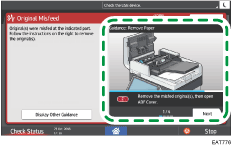
 Close all covers that have been opened.
Close all covers that have been opened.

If the jammed paper was torn apart while removing it, check that all pieces are accounted for.
If paper becomes trapped between the tray and the machine while removing jammed paper, pull out the tray completely and then remove the paper.
If the message remains displayed even after you remove the jammed paper, open the front cover completely and then close it. Check whether any paper is jammed in another location on the screen shown in Step 1 if the message persists.
Multiple paper misfeed locations may be indicated at the same time. When this happens, check all the areas indicated.
If there is no misfed paper in the area you check first, see the other areas that are indicated.
If paper misfeed message (B) appears, carefully remove jammed paper from behind the registration roller.
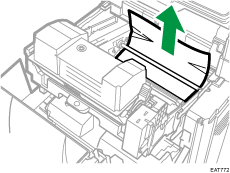
If a paper misfeed occurs, remove paper left in the machine or caught among parts of the machine.
If you notice a paper jam about to occur in the ADF, press [Stop] to pause scanning, and place the original in the ADF again.
If Paper Jams Occur Frequently
Check that the paper is loaded properly and the following settings are specified correctly.
Settings screen type: Standard
[Settings]
 [Tray/Paper Settings]
[Tray/Paper Settings]Settings screen type: Classic
[Settings]
 [Tray Paper Settings]
[Tray Paper Settings]
Paper condition
Items to check | Solution if applicable |
|---|---|
Are the sheets of paper in close contact with each other? | Fan the sheets thoroughly before loading them in the tray. 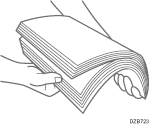 |
Are the sheets of paper curled? |
|
Is the paper flat and not folded or wrinkled? |
|
Is the paper dry and not moist? |
|
Is the cut surface of the paper smooth and clean? | If the cut surface is uneven, set the paper in a different orientation so that the cut surface faces another direction. When the paper supports duplex printing, turn over the paper. |
Is the paper too thick? Is the paper too thin? | Check the specifications for the paper that can be used on the machine, and load paper that is supported. |
Condition of the loaded paper
Items to check | Solution if applicable |
|---|---|
Are too many sheets of paper loaded? | Load paper below the upper limit mark ( |
Are the side fence and end fence in the paper source tray of the mainframe properly adjusted to the paper size? |
|
Is the bypass tray used correctly? |
|
Also check the basic procedure for loading paper into the machine again.
Tray Paper Settings
Items to check | Solution if applicable |
|---|---|
|
|

 or
or  ) in the tray.
) in the tray.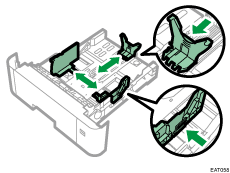
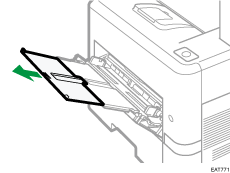
 ) after specifying the settings.
) after specifying the settings.